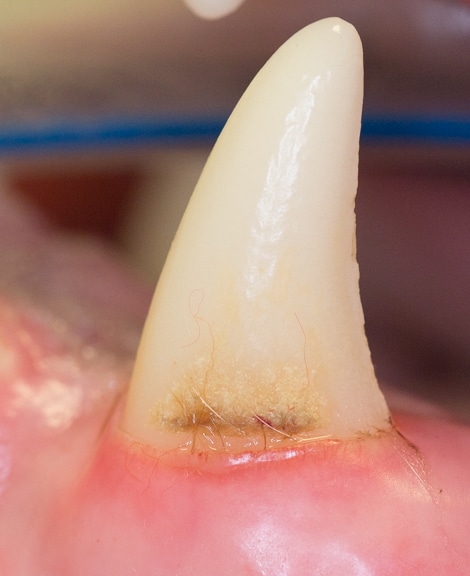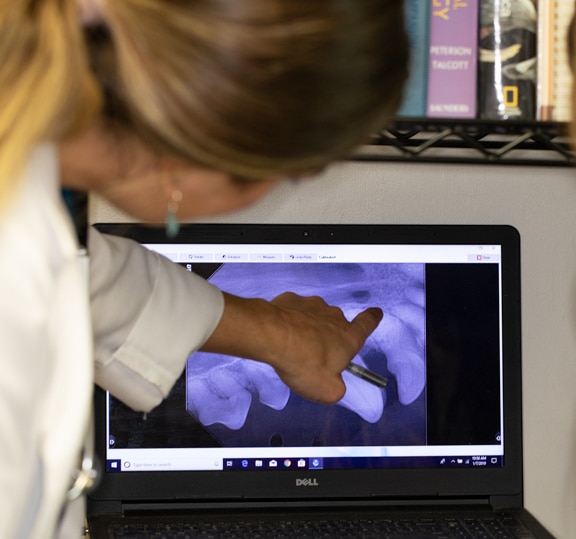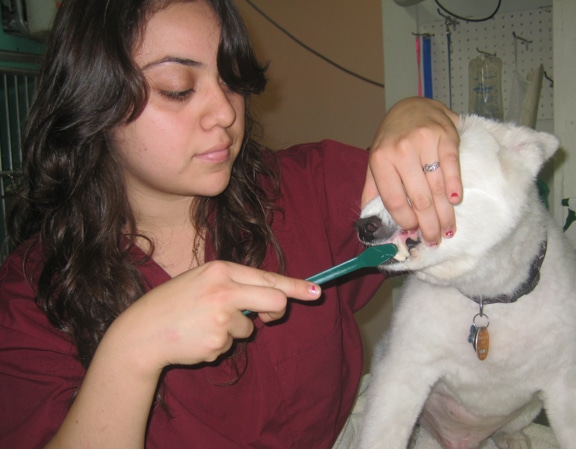Dental disease is prevalent in almost every adult dog and cat we examine. Prevention is the key, and in addition to professional cleaning which we provide, the most important thing you can do is to brush your pets teeth.
If started at an early age this “bonding time” is an enjoyable time for all. Start the brushing when the adult teeth are in, which is around 5 months of age.
You need to start brushing your pet’s teeth long before the start of plaque and gingivitis like in this tooth. Tooth brushing now will not correct this problem.
People sometimes wonder why pets need their teeth professionally cleaned by us, and also brushed by you, when they have memories of growing up with dogs and cats and never doing this. It doesn’t take much to answer this question.
Pets nowadays eat diets that makes them prone to plaque. They also live longer, and just like in people, are more prone to disease. A big reason is because we did not have the knowledge decades ago to understand how dogs and cats lived lives of chronic pain because we did not know or could not diagnose their dental disease.
With the advent of digital radiography, along with our growing body of knowledge, we realize that we did not treat dental disease anywhere near as thoroughly as needed.
One of the most important things you can do to slow down the recurrence of dental disease is to brush your pet’s teeth. This will help keep the gums healthy and prevent tartar buildup on the teeth on the cheek side (buccal) of the mouth, although it does not work as well on the teeth on the tongue (lingual) side of the mouth.
Even though this may sound like an impossible feat for an uncooperative pet, or even a ludicrous idea, it is one of the best ways to prevent dental disease.
Even though the teeth will eventually need professional cleaning again in the future (most people get their teeth cleaned several times per year), proper brushing will decrease the amount of dental disease that occurs and the number of times we will have to clean your pet’s teeth over its lifetime.
Due to the short life span of pets in relation to people, proper home care of your pet’s teeth becomes an important health measure.
When brushing the teeth there are some common sense things to do to make the process go smoother. One of our technicians will demonstrate some of these techniques with one of our hospital cats (they love the attention). It is important to remain calm and patient, since for most pets having something put into their mouths is a new experience. With a little tincture of time, the procedure progresses smoothly.
Also, it is highly advantageous to start the brushing process at an early age. Patience is the key! Try to do something positive (feeding it, playing or walking) with your pet just after brushing to condition the behavior for the future.
Our staff will show you how to brush your pet’s teeth
Try to make the whole process fun, don’t ever let on that you are doing something good for your pet (kinda like child psychology- if its good for them they won’t do it). With your pet near you or on your lap, maybe while watching TV, let your pet get used to your finger near its mouth. Dipping your finger into a food or liquid your pet has acquired a taste for helps start the process smoothly.
When it is comfortable with your finger, use a soft gauze to massage the gums and gently rub the teeth. A cotton tipped applicator can also be used. Eventually you want to progress to a toothbrush.
In smaller pets, especially cats, proper restraint is important. There needs to be a proper balance between too little and too much restraint, a balance that varies with each pet. This is especially true with cats.
For smaller pets, placing them on a table will make the process go smoother. Larger pets can also be placed on a table, if feasible, or can be restrained on the ground.
Only one or two people should be involved in the cleaning process, usually without children present. We have a complete page demonstrating this restraint technique.
Eventually, introduce a soft bristled toothbrush. These toothbrushes are available in our dental kits. A rubber finger brush can be used but a toothbrush is preferred. You should not use your personal tooth paste to brush your pet’s teeth because the taste can upset their stomachs. Our dental kit has toothpaste that is specially made to be palatable to animals.
These kits also have suggestions to make it easier to brush your pets teeth. If you consider daily tooth brushing a chance to enhance your bond with your pet, you and your pet will find it more enjoyable.
Brush the teeth in a slow and circular motion with a small amount of toothpaste. It’s important to brush the outside of the teeth (the teeth up against the lips and not the teeth up against the tongue) since that is where the plaque is most prevalent. If your pet is cooperative brush the insides next. Your goal is to brush at least 3 times per week. This will decrease plaque by 90%.
If you encounter resistance on a pet that normally lets you brush, or see blood or there are blood tinges on the toothbrush, smell any odor, see any inflamed area or swelling, or a buildup of tartar or inflamed gums, you should bring your pet in for an exam. If the tartar is significant it is time for a professional cleaning.
In some cases brushing is just not feasible. In these situations you can use sprays, gels and chew toys to control the buildup of bacteria. Another excellent way to prevent the tartar buildup that leads to gingivitis is the food called T/D. It is particularly useful for small breed pets, which are prone to significant dental disease.
Just like in people, routine preventive care is critical to proper dental hygiene. This saves your pet from extended periods of pain and unnecessary tooth loss, and can save you the expense of the veterinary care needed to treat advanced dental disease.
Your pet’s teeth should be checked every 6-12 months by one of our doctors, especially if it has already had gingivitis and had its teeth cleaned. Any pet that has had periodontal disease should be checked every 3 months. One of these check ups can be accomplished when your pet is brought to our hospital for yearly booster vaccinations.
You can learn much more about how we care for dental disease in dogs and cats by going to our Dental Page.




